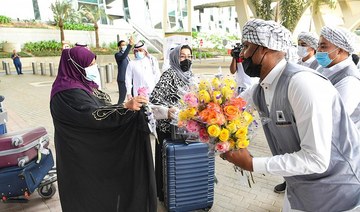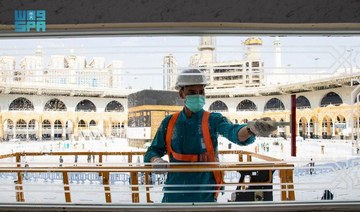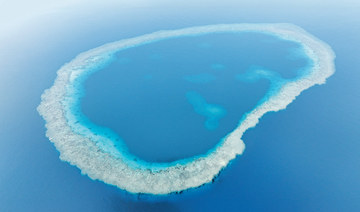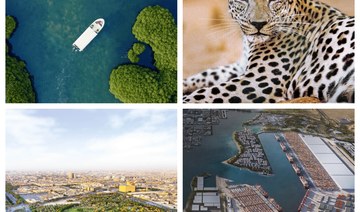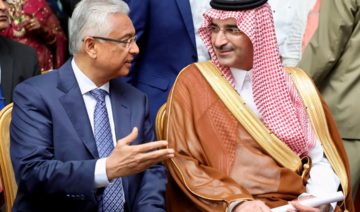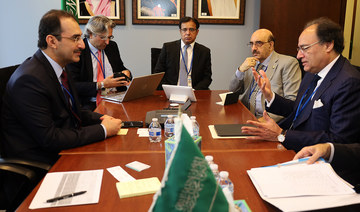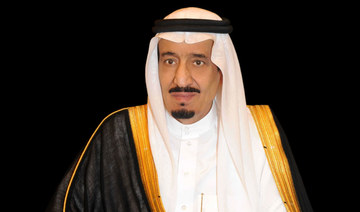JEDDAH: Saudi Arabia’s General Presidency for the Affairs of the Two Holy Mosques has allocated 25 new paths at the Mataf courtyard in the Grand Mosque in Makkah, including four for the elderly and people with disabilities.
The upgrade comes as part of plans to manage crowds amid the COVID-19 pandemic. Authorities will also apply all preventive and precautionary health measures to stop the spread of the airborne disease on the new paths of the courtyard.
Nizar Alaa El-Din, assistant undersecretary general of the presidency for grouping affairs and crowd management, said that the presidency manages groups of pilgrims “based on many factors and objectives,” and used its lengthy experience to coordinate with other parties and achieve effective communication with all groups working in the Grand Mosque.
He added that the presidency has benefited from numerous studies and mechanisms that have helped to build smooth and organized entries and exits at the holy site.
El-Din said that by organizing Hajj and Umrah each year, Saudi Arabia has “achieved global renown for its standards in transporting, protecting and managing crowds.”
The presidency also announced it has allocated 17 entrances to receive worshipers and pilgrims, and more than 100 guards have been employed in designated places.
Fahd Al-Maliki, the director of the Gates Department at the Grand Mosque, said that the doors are equipped with light signals and guiding panels directing people to vacant places inside the mosque.
Meanwhile, the General Presidency for the Affairs of the Prophet’s Mosque said it is doubling its field work to provide the best services to visitors to the Prophet’s Mosque during these blessed 9th, 10th and 11th days of the Muslim month of Muharram, which will end on Friday.
The services include providing Zamzam water to the masses of worshipers and those who are fasting in the Prophet’s Mosque.
Saudi Arabia’s Grand Mosque courtyard gets 25 new paths, 4 for elderly and disabled
https://arab.news/jwca3
Saudi Arabia’s Grand Mosque courtyard gets 25 new paths, 4 for elderly and disabled

- The Grand Mosque allocates 17 entrances to receive worshipers and pilgrims
- The Prophet’s Mosque redoubles its efforts to serve worshipers and visitors
Pakistan praises Saudi Arabia over facilitating Hajj for its nationals

- Pakistani pilgrims have been arriving in Madinah since May 9 when pre-Hajj flight operations were launched
- Pakistani minister is currently visiting Madinah to oversee Hajj arrangements for his nationals
RIYADH: Pakistani Minister of Religious Affairs and Interfaith Harmony Chaudhry Salik Hussain expressed his appreciation to Saudi Arabia for the exceptional services and facilities provided to Pakistani pilgrims who will be taking part in Hajj this year.
Minister Hussain’s remarks came in a statement delivered in Madinah, where he is currently visiting to oversee Hajj arrangements for Pakistani pilgrims, the Saudi Press Agency reported.
Pakistan has a Hajj quota of 179,210 pilgrims this year, of whom 63,805 will perform the pilgrimage under the government scheme while the rest will use private tour operators. This year’s Hajj is expected to run from June 14-19.
Pakistani pilgrims have been arriving in Madinah since May 9 when pre-Hajj flight operations were launched. Over 20,000 Pakistani pilgrims have so far arrived in Madinah under the government scheme.
The Pakistani official particularly praised the Saudi leadership for launching the Makkah Route Initiative at Karachi International Airport, mirroring the program already established at Islamabad International Airport.
Hussain said he was confident the initiative would be extended to Lahore Airport in the coming year.
KSrelief continues aid projects in Sudan, Yemen and Greece

- 26 neurosurgeries were done in Sudan
- 330 relief trucks delivered 5,752 tonnes of aid to Yemen
RIYADH: The Kingdom’s aid agency KSrelief continued its projects in Sudan, Yemen, and Greece.
In Sudan, KSrelief implemented a medical volunteer project for neurosurgery and spine surgery from May 12 to May 17.
About 15 volunteer specialists from various medical fields assisted in performing 26 surgeries, the Saudi Press Agency reported.
In Yemen, KSrelief provided a convoy of 330 relief trucks, which delivered over 5,752 tonnes of critical supplies to people across 14 Yemeni governorates.
The aid included food, medical supplies, and shelter materials.
Additionally, KSrelief donated 10 tonnes of dates to Greece, which were presented by Saudi Ambassador to Greece Saad Al-Ammar to Athens.
How forest conservation is helping Saudi Arabia achieve its green objectives

- By planting trees and protecting forests, the Kingdom promotes biodiversity and sustainable development
- Forests provide habitats for hundreds of animal species and play a pivotal role in combating climate change
JEDDAH: With its low annual rainfall, much of Saudi Arabia’s vast landscape is covered by desert, broken by occasional oases. In its mountainous regions, valleys, and along its coastline, however, the Kingdom is home to multiple forest ecosystems.
Forests play a pivotal role in combating climate change by acting as carbon sinks — storing carbon both above and below ground, thereby extracting it from the atmosphere, where it would otherwise contribute to the greenhouse effect.
Their significance in climate change adaptation and mitigation is also underscored by their role in creating local microclimates, providing habitats for a wealth of biodiversity, locking in freshwater resources, and preventing flash floods, landslides, and soil degradation.
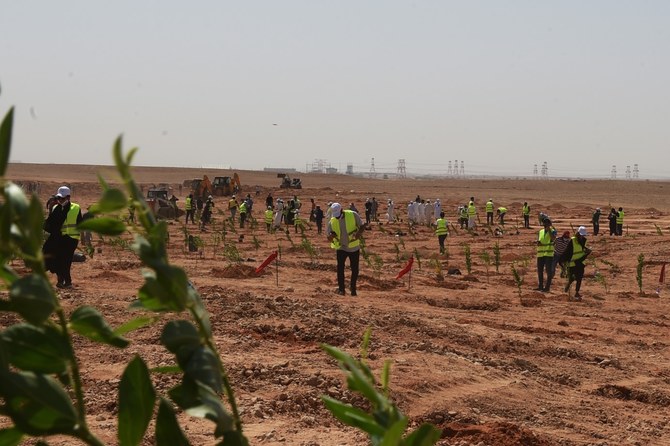
Saudi Arabia’s National Center for Vegetation Cover Development and Combating Desertification is at the forefront of implementing the Kingdom’s strategic goals outlined in Vision 2030.
“Forests play a crucial role in mitigating climate change,” Samir Malaika, assistant director-general of the general administration of forests at NCVC told Arab News. “Saudi Arabia’s dry climate and geography hinder its efforts to conserve forests and promote plant growth.
“With most areas receiving minimal rainfall, forests struggle to thrive. The escalating impact of climate change exacerbates environmental stressors, hampering forest growth and regeneration efforts.”
The NCVC aims to elevate living standards by reducing pollution and facilitating the restoration of degraded environments. It is also committed to building resilience against natural hazards and defenses against harmful pests that could pose risks to vegetation.

Simultaneously, it prioritizes the sustainable development of the Kingdom’s natural resources. With seven ongoing initiatives, it aims to ensure the responsible and lasting utilization of resources in line with the nation’s sustainability objectives.
Among the center’s key initiatives under the Saudi Green Initiative is a scheme to plant some 10 billion trees — representing a significant step in the Kingdom’s reforestation effort.
The initiative for forest management and sustainable development by 2030 underscores a long-term commitment to nurturing and preserving woodland environments.
The phased approach to preserving and restoring vegetation in pasture areas reflects a strategic focus on addressing the specific ecological challenges faced by different ecosystems.
Opinion
This section contains relevant reference points, placed in (Opinion field)
Furthermore, the initiative for developing vegetation and infrastructure for 50 national parks highlights the importance of creating protected natural spaces while promoting biodiversity and ecotourism.
Moreover, the initiative to plant 7 million wild trees in royal reserves demonstrates a targeted effort to enhance the natural habitats within these pristine areas.
Engagement by the public and private sectors in vegetation development and combating desertification underscores the collaborative approach needed in order to achieve sustainable environmental goals.

By harnessing the collective resources and expertise of various stakeholders, these initiatives aim to create a resilient and thriving ecosystem that benefits both present and future generations.
According to Malaika, Saudi Arabia boasts a forest coverage spanning approximately 2,768,050 hectares, primarily concentrated in the southern and southwestern regions, along riverbeds, and on the coastlines of the Red Sea and the Arabian Gulf.
These forest ecosystems are categorized into three primary types: mountain, valley, and mangrove.
Mountain forests
Mountain forests are predominantly located in the region spanning the Hijaz Mountains in Taif to Jazan in the south. These areas have neutral soil acidity and receive the highest rainfall and humidity levels, particularly evident in the southwest with denser forest cover.
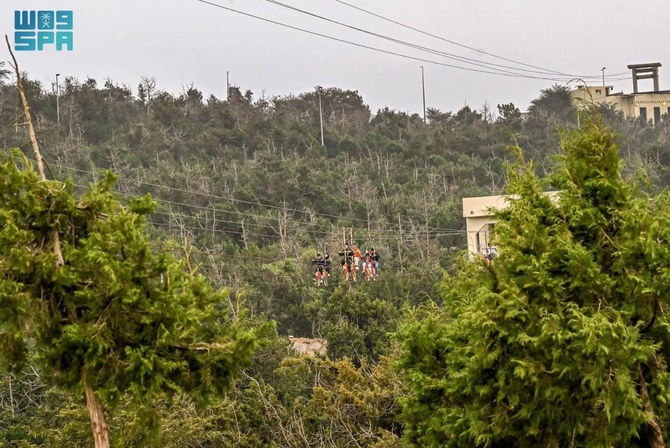
Forests are made up of several Juniperus plant species, typically found at altitudes of 2,000 meters and above. Additionally, Olea chrysophylla forests, characterized by wild olive trees with golden leaves, thrive at altitudes of 1,500 to 2,000 meters.
At lower altitudes, between 1,000 to 1,500 meters, Acacia plant species dominate the landscape.
Notably, terraced agriculture is a common feature of mountainous regions, facilitating crop fruit tree cultivation while aiding in water retention and soil protection. However, improper management can lead to land degradation, adversely affecting the surrounding forests.
DID YOUKNOW?
• Saudi Arabia is home to more than 63 unique ecosystems, ranging from mountainous regions to coastal lowlands.
• The Kingdom boasts a diverse array of wildlife, including 78 terrestrial mammal species and 499 species of bird.
• Coral reefs in Saudi Arabian waters host an impressive 266 species, contributing to marine biodiversity.
• With more than 6,500 species, Saudi Arabia’s invertebrate population testifies to the richness of its ecosystems.
• Saudi Arabia boasts three distinct forest ecosystems: mountain forest, valley forest, and mangrove forest.
Valley forests
Saudi Arabia’s topography features 179 valleys distributed across the country. Valley forests, mainly situated in semi-arid regions, are characterized by species such as Acacia ehrenbergiana, Acacia tortilis, Maerua crassifolia, several species of Commiphora, and Salvadora persica.
Additionally, oases and valleys are abundant with various Acacia species, Ziziphus spina-christi, Salvadora persica, Haloxylon persicum, trees, shrubs, and Hyphaene thebaica.
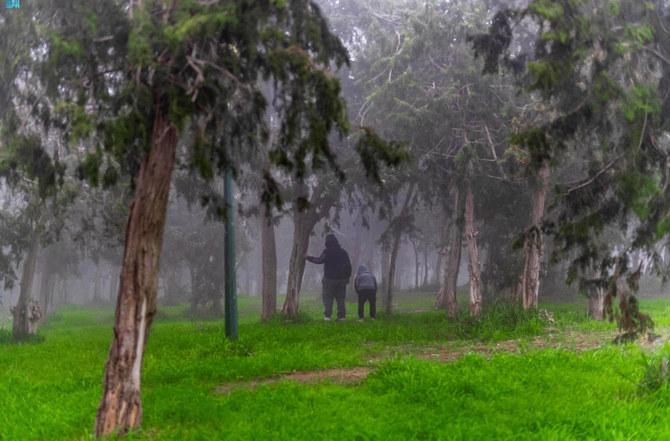
Mangrove forests
Mangroves and coastal ecosystems tolerant to saltwater are predominantly located along the Red Sea coast, with other stretches found along the Arabian Gulf coast.
Despite the lack of comprehensive forest data, studies indicate significant degradation of the mangrove ecosystem.
Avicennia marina is the most prevalent species in mangrove forests, with Rhizophora mucronata being less common.

Besides these natural forests, the Kingdom is also host to many urban and cultivated woodlands in its parks and residential neighborhoods, planted to provide shade, reduce temperatures, and beautify city streets.
Despite the Kingdom’s diverse ecosystems, it faces significant challenges in preserving and expanding its forests, including limited resources, poor local management, insufficient nursery production to meet seedling demand, a lack of awareness about dumping and unauthorized grazing, and other irresponsible human activities.
The Saudi National Center for Wildlife is working to protect, develop, and restore ecosystems and biodiversity around the Kingdom, in addition to addressing risks related to plant and animal life.
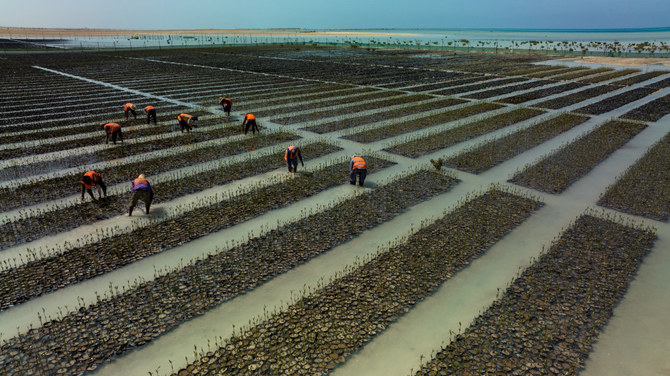
According to Abdulmanea Al-Qahtani, invertebrates department director at the NCW, the Kingdom has 63 distinct ecosystems, encompassing a diverse range of landscapes, including mountains, plains, deserts, valleys, forests, seas, wetlands, plateaus, coastal areas, and marshes, all teeming with biodiversity.
The Kingdom is home to 78 species of terrestrial mammal, 499 species of bird, 136 species of reptile, seven species of amphibian, and more than 6,500 species of invertebrate.
In its waters, the Kingdom also offers habitats to 19 species of marine mammal, eight species of freshwater fish, 1,248 species of saltwater fish, and 266 species of coral
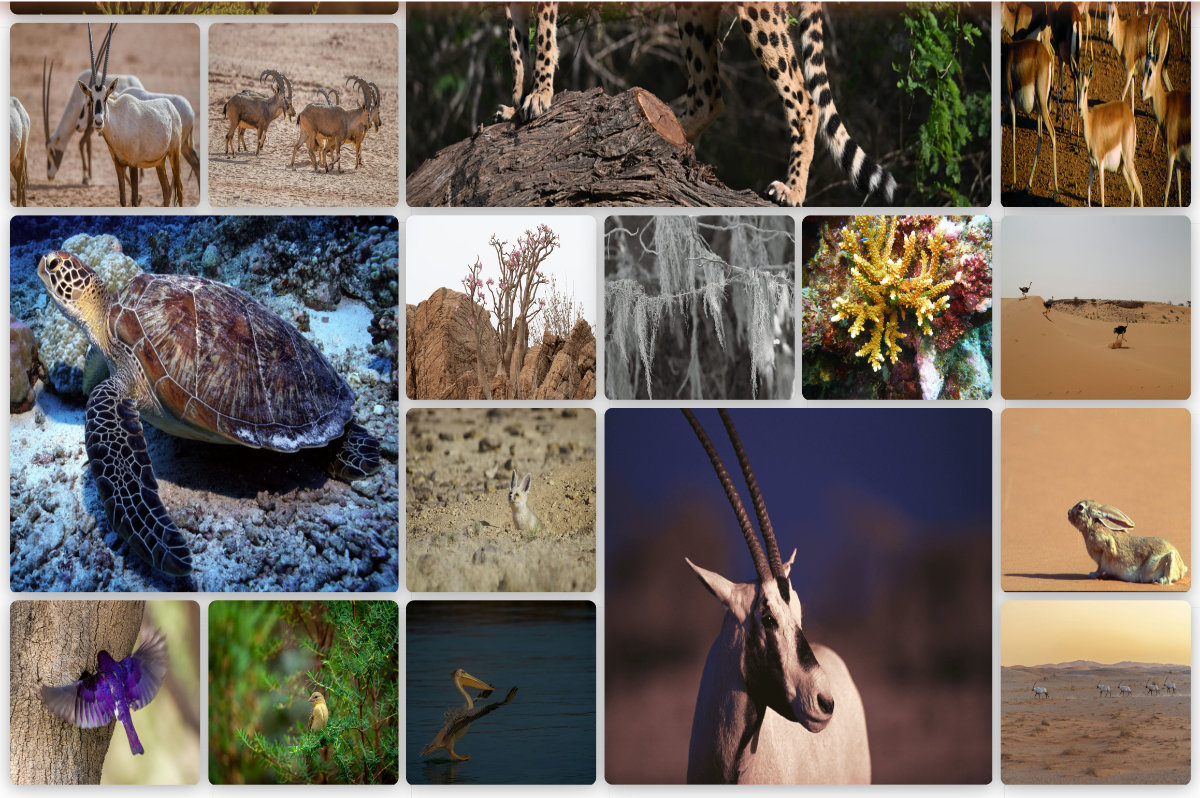
The Saudi Green Initiative, launched by Crown Prince Mohammed bin Salman in 2021 under the Vision 2030 framework, aims to tackle threats to this rich biodiversity and foster sustainable development.
Key goals include transitioning to a sustainable economy by reducing carbon emissions, boosting renewable energy production, and bolstering conservation efforts.
Additionally, the initiative aims to enhance environmental protection, promote green technologies, and create green jobs to drive economic diversification and growth.

Saudi fund signs two loan agreements, inaugurates Hulhumale Island development in Maldives

- Al-Marshad participated in the partial inauguration of the Hulhulmale Island Development Project
MALE: CEO of the Saudi Fund for Development Sultan bin Abdulrahman Al-Marshad signed on Friday two development loan agreements with the Maldives’ Minister of Finance Dr. Mohammed Shafiq. These agreements will contribute to financing the Velana International Airport development project with a value of $100 million and the healthcare sector development project in the Maldives with a value of $50 million, provided by fund.
Additionally, Al-Marshad participated in the partial inauguration of the Hulhulmale Island Development Project, which the SFD is contributing to financing through a soft development loan worth $80 million. The event was also attended by Saudi Ambassador to the Maldives Matrek bin Abdullah Al-Ajalin.
King Salman issues royal order to promote 26 judges

RIYADH: King Salman issued a royal order on Friday to promote 26 judges at the Board of Grievances, Saudi Press Agency reported.
President of the Board of Grievances and Administrative Judicial Council Sheikh Khalid bin Mohammed Al-Yousef said that the royal order confirmed the keenness of the Kingdom’s leadership to support the judiciary to develop its performance and achieve quality and efficiency.
Earlier this month, the king issued a royal decree on Saturday to appoint 261 investigative lieutenants at the Ministry of Justice’s Public Prosecution.








